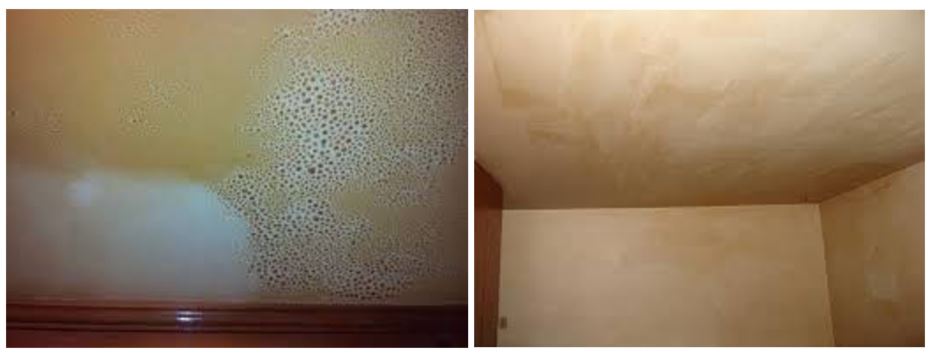Background
In this Head Scratcher, you are a paint company/R+D chemist, and your largest contracting customer has been given the contract to paint the largest hotel in Qatar, with over 500 rooms on 40 floors. Until recently, it was a smoking only hotel, so the ceilings and walls of every room look like the pictures below.

You have to provide products for the following five surfaces/situations. Your task as a manufacturer/chemist is three-fold:
- Identify what traits the five different products need to have
- Adjust three starting formulations to give the desired properties, considering that the customer wants the paint to meet the EU 2010 rules for volatile organic compounds (VOC)
- Determine how biocide choices change if you also follow EU Rule 43 rules on incan and dry film biocide
Surface 1: Room and passage walls and ceilings
The customer wants a primer. Which is more important: adhesion/penetration or stain blocking?
Solution: Actually both are very important so you have two real choices:
- A solvent-borne Acrylic Polymer that has been emulsified into water. An example is Eliokem’s Hydro-Pliotec but in many countries local polymer companies have developed their own versions which seem to work well when used at Pigment Volume Concentration (PVC), just above Critical Pigment Volume Concentration (CPVC), using Talc and Diatomaceous Silica for stain blocking /matting/restrictive application. But there are three issues:
- they do have an odour
- they cannot always be packed in plastic. Acrylic Polymers warp plastic with time if it’s not fluorinated so most people still pack this type of product in metal cans (at a much higher price).
- sometimes the solvent allows nicotine to bleed through. A test area would have to be applied.
- A nanoparticle-sized emulsion which binds and penetrates. I have seen versions based on Acrylic, Styrene Acrylic and Pure Acrylic. All tend to be sub 50 NM (30-40 NM) in particle size so the solids tend to be low (30-35 percent) which can make formulating difficult/costly but they do work and can be packed in plastic. They tend to formulated again at 60-65% PVC on Talc and/or Diatomaceous Silica to get the right balance of penetration/adhesion and stain blocking, sometimes on acrylic thickeners (HASES) but also on urethanes (HEURS) defoamer. Type and level is extremely important, although nicotine stain bleed-through is less likely going to be an issue with this polymer choice. We would always recommend a test area just to be 100 percent certain that it does not occur.
Surface 2: Passage
Two coats of a washable matt in a cream Colour. Time is short so they want the walls spray-applied and they want to be able to touch up with a roller or brush.
Solution: We need to make the coating very matt/even, with a very closed/foam-free film that flows well so that you do not see a difference in sheen/flow or Colour between the spray and the brush/rolled areas. See the formulation below for proposed changes.
DOWNLOAD QATARI ULTRAMATT FORMULATION [PDF]
Surface 3: Room ceilings
The customer wants a white medium to low cost, very matt paint to cover the ceilings in one coat applied by roller. He is going to paint the walls before the ceilings so the white paint must not splatter.
Solution: We need to improve the flow, reduce splatter, make more matt and more restrictive without putting up the cost too much. See the modified formulation below.
DOWNLOAD NORMAL CEILING PAINT FORMULATION [PDF]
Surface 3: Bathroom ceilings
Two coats of a white matt that not only covers well but does not steam stain or grow fungus, especially in the cooler more humid Qatar winters.
Solution: We need to improve water resistance whilst retaining matt finish and restrictive application/less splatter. We would achieve this by dropping PVC, using a mid-shear urethane and adding an EU Rule 43-suitable dry film biocide. See revised formulation below.
DOWNLOAD BATHROOM CEILING PAINT FORMULATION [PDF]
Surface 4: Passage way ceilings
The customer wants a very high build, white textured paint that not only hides imperfections, but also covers the nicotine staining and effectively deadens noise.
Solution: You need a heavy viscosity, or to build more sag resistance and texture as well as something to deaden sound. Vermiculite, which is a porous volcanic rock, helps with this. See the revised formulation below.
DOWNLOAD TEXTURED CEILING PAINT FORMULATION [PDF]
Looking for more coating formulations?
Prospector® has you covered! From primers, to lacquers, to automotive clearcoats, find hundreds of formulations in our materials search engine. Sign up today and get our bi-monthly newsletter for free!
Register for Prospector
The views, opinions and technical analyses presented here are those of the author or advertiser, and are not necessarily those of ULProspector.com or UL Solutions. The appearance of this content in the UL Prospector Knowledge Center does not constitute an endorsement by UL Solutions or its affiliates.
All content is subject to copyright and may not be reproduced without prior authorization from UL Solutions or the content author.
The content has been made available for informational and educational purposes only. While the editors of this site may verify the accuracy of its content from time to time, we assume no responsibility for errors made by the author, editorial staff or any other contributor.
UL Solutions does not make any representations or warranties with respect to the accuracy, applicability, fitness or completeness of the content. UL Solutions does not warrant the performance, effectiveness or applicability of sites listed or linked to in any content.



Very interesting subject, especial covering all the new VOC and biocide rules
in formulations.